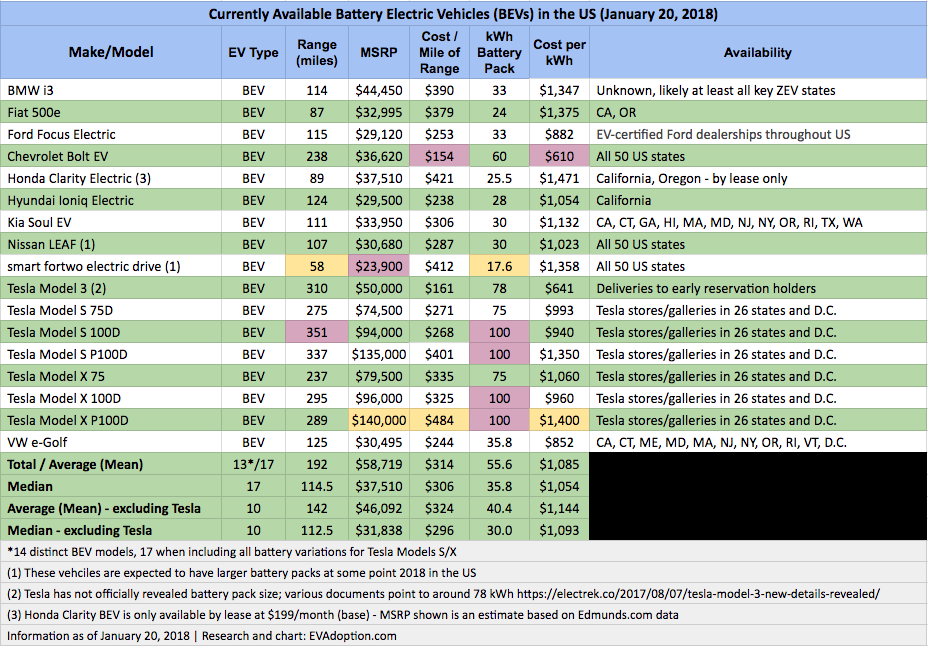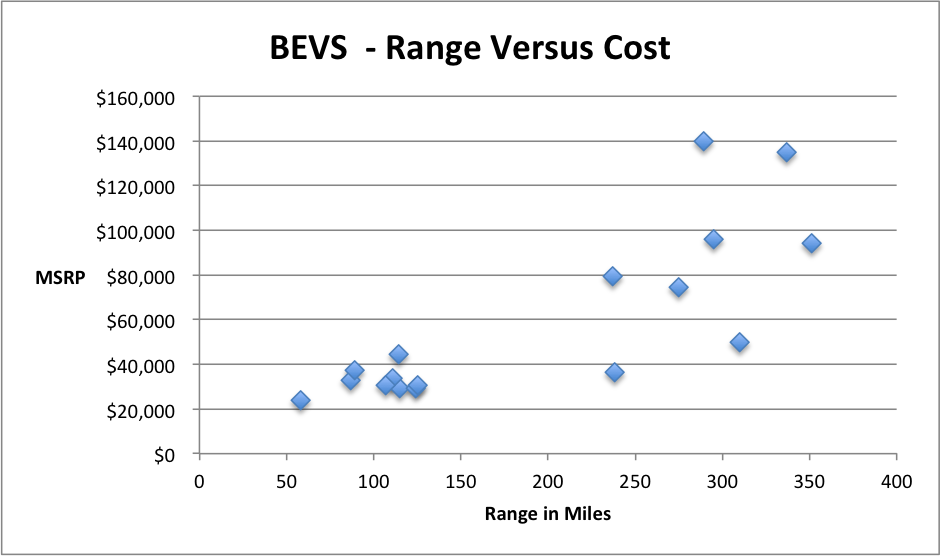In this weeks “stat of the week,” we dive into analyzing the range, MSRP, battery pack size and cost per mile of range/battery pack kWh for battery electric vehicles (BEVs). Plug-in hybrids (PHEVs) are not including in this analysis, but please check out our recent statistic of the week and analysis of PHEVs.
Number of BEVs Available in the US
There are 13 battery-electric vehicles (BEVs) available in the US as of January 20, 2018, exactly half the number (26) of available plug-in hybrids (PHEVs). Tesla remains the only manufacturer with more than one BEV available (Models S, X and 3). If you include all battery pack variations of the Tesla Models S and X, then there are a total of 17 different BEVs.
For calculating averages, I use both mean and median. And to assess Tesla’s impact on these averages I slice the data across all 17 BEVs and also compare to just the 10 non Tesla BEVs.
In 2017, two BEVs were discontinued: the Mercedes-Benz B250e and the Mitsubishi iMiEV. Both models were poor sellers, but the Mitsubishi only sold roughly 200 units in total since 2015. The Mercedes sold a bit better, but never found a market and could not compete well directly against the BMW i3, or with lower-priced Models like the Nissan LEAF or higher priced Teslas. The B250e sold 4,056 models since 2014 and only 744 in 2017. The B250e will be replaced by Mercedes’ new EQ line of BEVs beginning likely in 2020.
Average Battery Range
When including all variations of the Tesla Models, the mean battery range is 192 miles, while the median range is 114.5 miles. Excluding all of the Tesla models and the mean drops to 142 and the median declines to 112.5 miles of range. The Tesla models increase the mean range by 50 miles but at a mean price difference of more than $12,600 higher.
The Tesla Model S 100D has the highest battery range at 351 miles, while the smart fortwo electric drive pulls up the rear with 58 miles of battery range. Three BEVs have a range of below 100 miles: smart fortwo (58), the Fiat 500e (87) and Honda Clarity Electric (89).
Including all variations of Tesla models, there are 8 BEVs with more than 200 miles of range, but the Chevrolet Bolt (238) is the only non Tesla with this level of range. This will change in 2018, with models from Audi, Jaguar, Hyundai and Kia (and the 220 mile version of the Tesla Model 3) expected to reach US dealers by the end of 2018.
Average MSRP
The mean Manufacturer’s Suggested Retail Price (MSRP) of the 17 BEVs is $58,719 and the median price is $37,510. These average prices drop pretty significantly when excluding the Tesla models to a mean of $46,092 and median of $31,838. This compares to the the average sales price of $31,790 in 2016 and the $35,000 average selling prices of vehicles in the US as of January 2017 (latest and data I could find).
Cost Per Mile of Range
The Bolt takes the top prize for the lowest cost per mile of range at $154, followed by the Tesla Model 3 at $161 (based on an estimate of the Model 3 battery pack at 78kWh – Tesla has not officially announced the size of Model 3 battery packs). The $145,000 high-performance Tesla Model S P100D not surprisingly has the highest cost per mile at $484.
Mean cost per mile of range is $314, while the median is $306. Without the Tesla models, mean is $324 and median cost per mile of range is $296.
Cost Per kWh
The Chevrolet Bolt has the lowest cost per kWh at $610 with the Tesla Model 3 not far behind at $641. On the high end, six BEVs are at or near $1,400 per kWh of an EV’s battery pack. The Honda Clarity Electric takes the high-cost crown at $1,471 per kWh, followed by the Tesla Model X P100D at $1,400. The BMW i3, Fiat 500e, smart fortwo and Tesla Model S P100D are not far behind with all of them north of $1,300/kWh.
Subscribe to our email alerts now!
What Does This Data Tell Us?
While today, BEVs comprise only one-third of the US available EVs, by 2022 they will likely comprise half of the available EVs based at least on current announcements of future plans by automakers.
With several new 200+ mile range EVs coming to market in 2018, upgrades of some existing models and perhaps discontinuation of some of the sub-100 mile BEVs – it is likely at some point in 2019, the mean BEV range will reach 200 miles.
At the moment, however and as the plot chart above reveals, there is potentially an opportunity for automakers to hone in on the current uncompetitive space of BEV range between 125 to 225 miles. The 2018 Nissan LEAF will enter that space with its 150 miles of range when it reaches market later this year. Hopefully we will also see the Hyundai Ionic, BMW i3 and Kia Stonic in the 150-200 miles of range category in 2018.
Finally, the Bolt and Model 3 reveal the obvious – that a key to future success and adoption of EVs is low cost per kWh achieved through a reasonable price of the vehicle combined with a good-sized battery pack.
Related links and resources:
 Announcing the acquisition of EVAdoption by Paren →
Announcing the acquisition of EVAdoption by Paren →


7 Responses